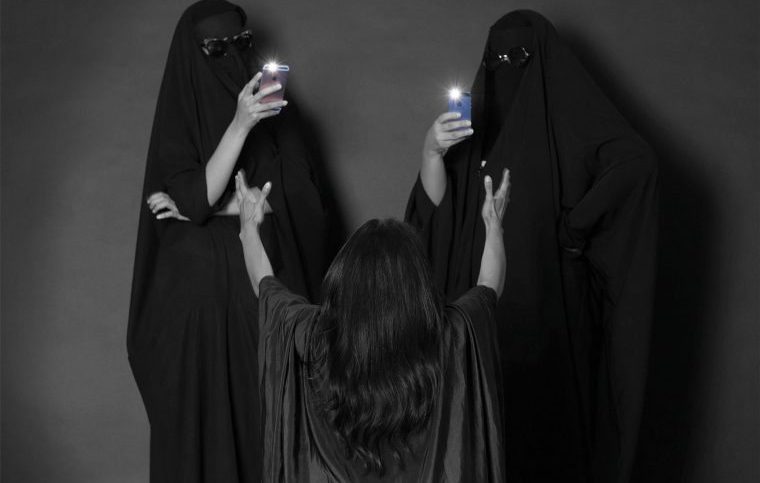What is a bully? What does it mean to be bullied? Conceptual artist Abdullah Al Saab certainly had a way of explaining the social issue through his latest exhibition in Dar Al Funoon, dubbed “BULLYing”. It was a sensitive topic to tackle, but being a self-defined curious person, Abdullah finds inspiration in almost everything and believes that not taking risks in life is the biggest risk there is. Based on his past achievements and works he’s done, the recurring message of “risk” coupled with his background education in Interior Design and Psychology is apparent throughout his whole journey.
Originally conceptualizing himself as a fashion designer, the artist found himself combining fashion and visual art, coining this form of expression by collaborating with artists like Shurooq Amin in 2011, creating clothing designs painted over with Shurooq’s original artwork and displayed in the FA Gallery in Kuwait City. The artist also collaborated with his brother and well known local artist Hamad Al Saab, who’d implemented his signature vintage Arabic cultural prints onto Abdullah’s 1960s inspired pieces, displayed in Dar Al Funoon in 2008.
Still, Abdullah had more to say that he couldn’t always express through fashion, and showed the nation as he released his debut independent pictorial concept dubbed “Boundaries” in Dar Al Funoon, in 2013. “Boundaries showed a series of social issues with elements of white over black, meant to symbolize what he called ‘the peak of hope’. The result of this exhibition was wildly successful as two of his pieces were sent to Los Angeles to stand in the permanent collection of the Islamic Art Now: Contemporary Art of the Middle East exhibition in LACMA (Los Angeles County Museum of Art).
BULLYing, which ran from December 6-10, 2015 was surely a body of work to be proud of, as it touched on a global social issue that isn’t always addressed. This exhibition displayed twenty different ways to classify bullying, with abaya and niqab clad women wearing colored sunglasses to illustrate the idea of blind sightedness to their surroundings. “People don’t understand that this is bullying,” raved Abdulatif Al-Kharji, longtime friend and fan of the artist’s work; “But I’ve witnessed this line of work from start to finish, and watching the reactions people had, from the tears in their eyes to the way the pieces made them discuss, was beautiful. It was amazing to hear witness everybody’s different points of view.”
As a whole, BULLYing was an extremely thought provoking exhibition, and bazaar was lucky enough to meet with the artist himself to discuss his inspiration and processes behind the pieces.
What inspired you to create a whole range of works dedicated to bullying?
The theme had originally started out as ‘Superficial Starvation’, which is ultimately a vague element of bullying. With personal experiences, I began to notice that we as people don’t see the lines that separate inappropriate and appropriate things to say to people, and brush it off as part of our extremely honest culture. In that respect, we don’t talk about bullying enough, and we should raise more awareness. This prompted me to research the different types of bullying people are exposed to, and to look at statistics. 82% of people have felt bullied on the daily, and my logic is the remaining 18% would be children who are too young to speak eloquently. Knowing this scared me, and made me realize that the whole world constantly feels bullied, and something needs to be done about it.
What does bullying mean to you?
Bullying is a highway to self-destruction – if you don’t know how to drive in the dark, you end up being lost. It’s a choice, you make the choice if you want to be sucked in, or you can tell yourself that you’re bigger than this and you won’t let it effect you.
How do you feel these works convey the message you’re trying to spread?
First and foremost, I would like to provide a disclaimer: none of the photographs represent any sort of belief or cultural reference – a lot of people assumed that when they saw it referenced a certain lifestyle. I’m a person who respects my culture very much, but the main thing that holds everything together is the abaya and niqab, and my reasons for choosing to use these elements are extremely particular. As human beings, our emotions live within our skin, and the niqab and abaya protect the skin and facial expressions – if I’m covering my emotions and facial expressions, what gives you the right to judge me? I also didn’t want people to get attached to anyone behind the pieces – I wanted the emotion of the photos to speak louder than the element of the human face would. In that respect, the message is delivered in an extremely powerful way, drawing attention to the symbolism of the figures’ actions, and making images of those with exposed hair or even with an exposed eye more vulnerable.
What inspired you to use women as subjects for your pieces?
The reason I have no male elements in these pieces is because to me, the source of kindness, emotions and care comes from a woman (our mothers, for example). I also feel that the female element is always easy for a human being to relate emotions to, and that the softness of a woman is easier on the eyes – they’re easier to connect to. If I were to use male elements, there would be an obvious double standard, but by using feminine elements I feel that its easier for people to relate to on both ends. That being said, I believe that a woman can do anything a man can do, but in this case, women do it better.
Do you feel that the response has been positive?
The response has been fantastic. I’m so happy with how supportive people have been, and how I’ve managed to make it so personal to a lot of people. I realize that the subject matter is a risky one, and that there’s a fine line between touching an audience and insulting them. People relate to it and they’re more understanding than I thought they’d be. The concept was meant to be a hit or miss, and I’m confident to say the outcome was a hit.
Do you think visual aids such as these help people realize that bullying is an issue?
I really hope so. I’m not expecting an overnight change and I’m a very realistic person – I know this wont stop bullying, but if it raises awareness and helps maybe one person, I know that my message has come across successfully.
How do you feel about the way bullying is dealt with in the region?
We aren’t talking about it enough, or raising enough awareness. Bullying can happen unconsciously without being aware of the consequences, and the media doesn’t help! How easy everything has become has made people lose the value of a lot of things, like friendship, for example: it used to take a lot of work for someone to be your fired and now all you have to do is add them on Facebook to get to know them. With everything so easy and accessible, a sense of boredom and entitlement erupted and issues such as these are shoved to the backburner or people think its normal to treat others a certain way.
Do you have any words of wisdom to bullies and the bullied?
When it comes to being bullied, remember this: Mind over matter. No matter what happens to you, you can always overcome that and grow a thicker skin – look at the greatness of everything you’ve achieved, and when people point the finger at you, it isn’t always personal. Always read between the lines- the minute you do, you will realize the patterns of human nature, and it will be easy to move on.
As for the bullies, I cannot attack them—they are victims of the social norm and evolution of social media around them. They are victims of wanting to be a part of something, and because things have become so easy, they think they can get away with it. But to both, I have to say, no matter what your interests are, how old or young, it doesn’t matter; you are the center of your own life. You choose how your life goes, and no one has the right to choose for you just like you have no right to choose for anyone else – remember that.
Discover Abdullah’s work by visiting his website at www.abdullahalsaab.com.












